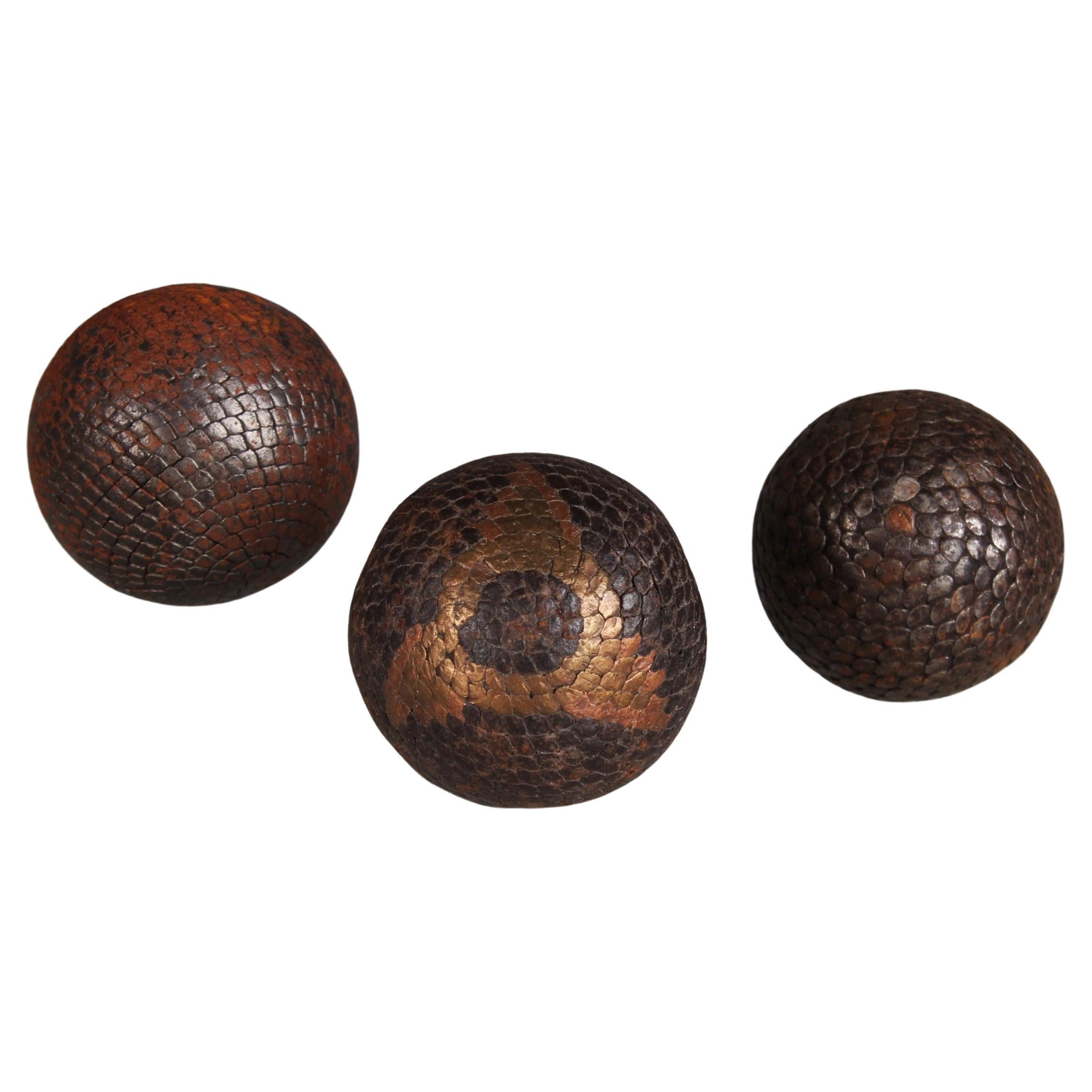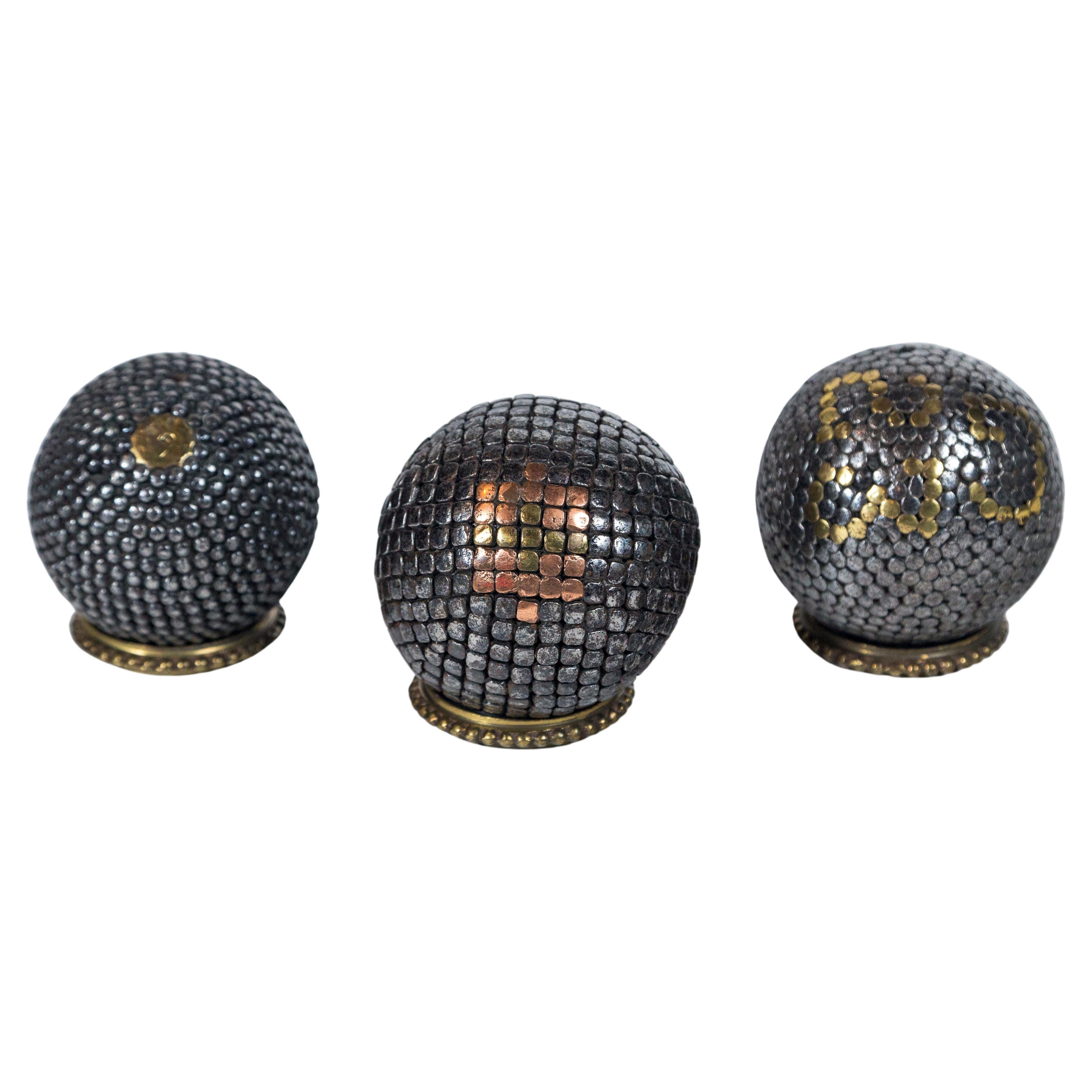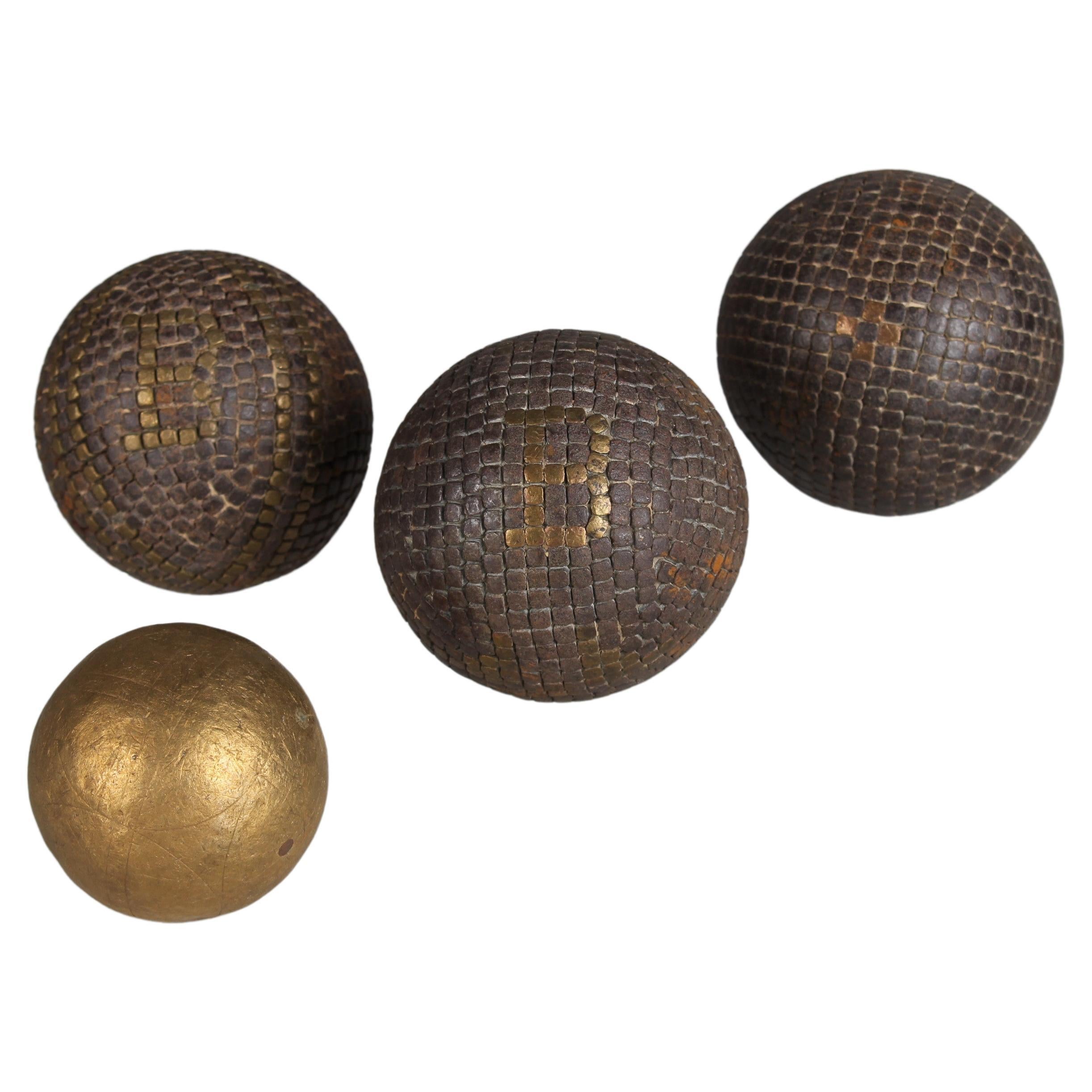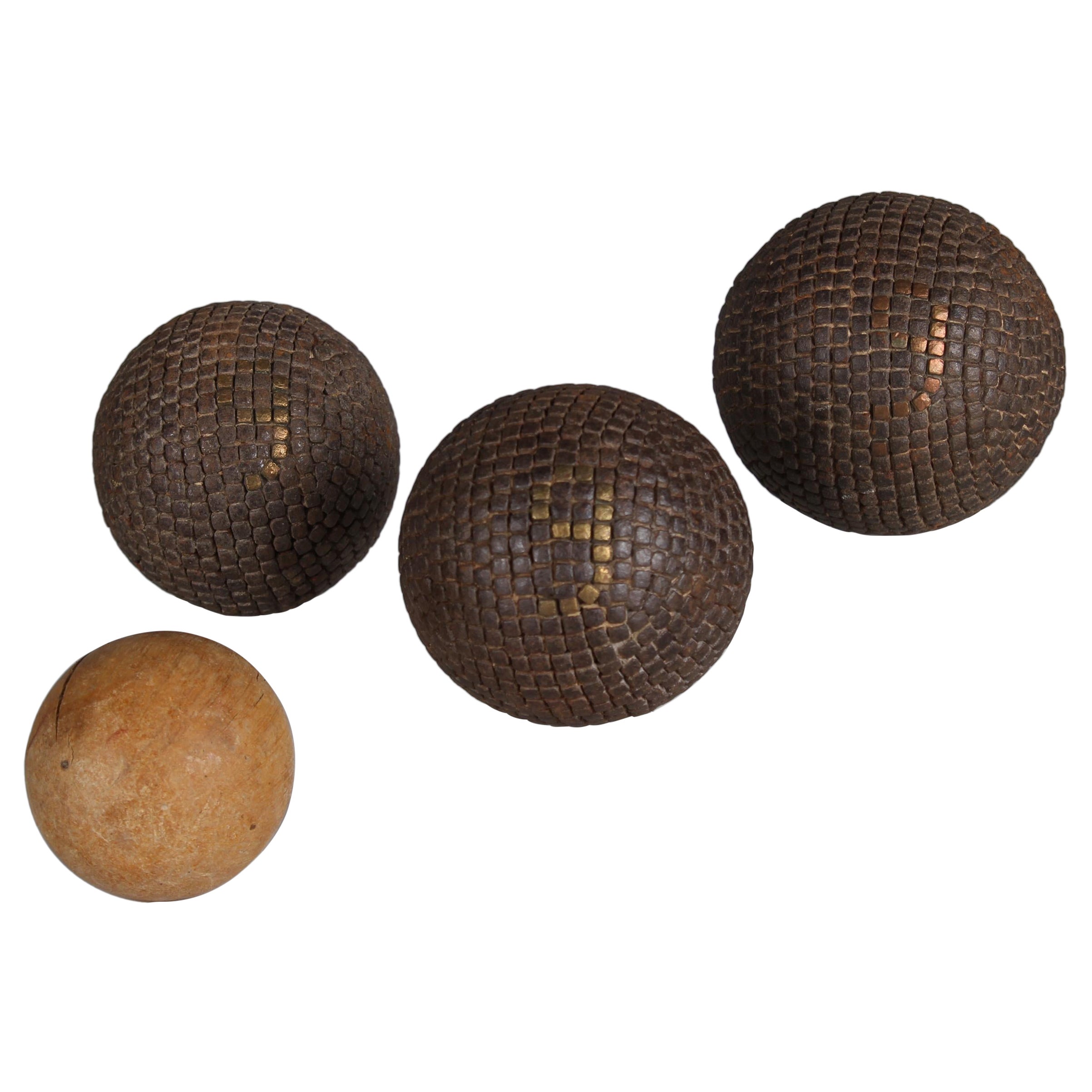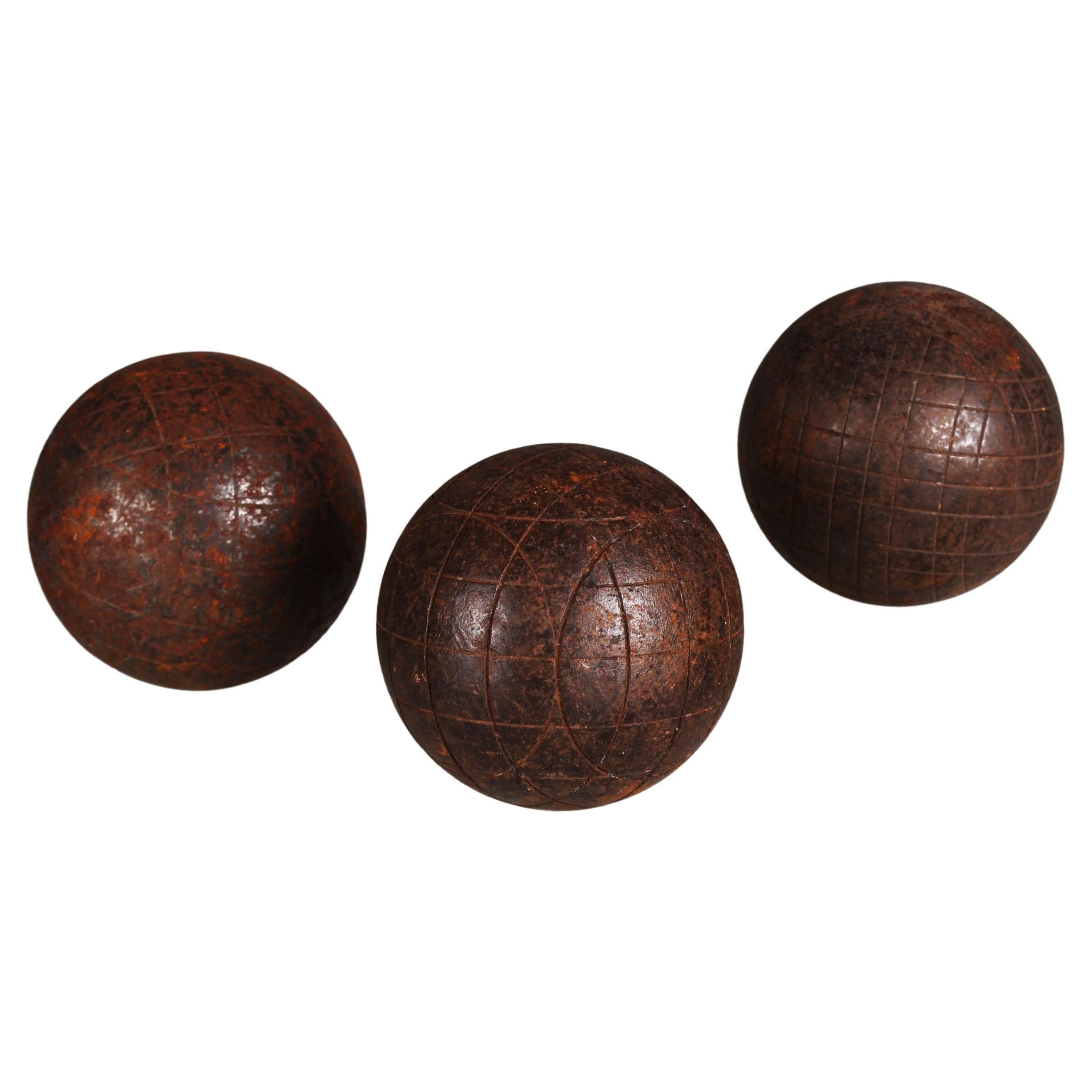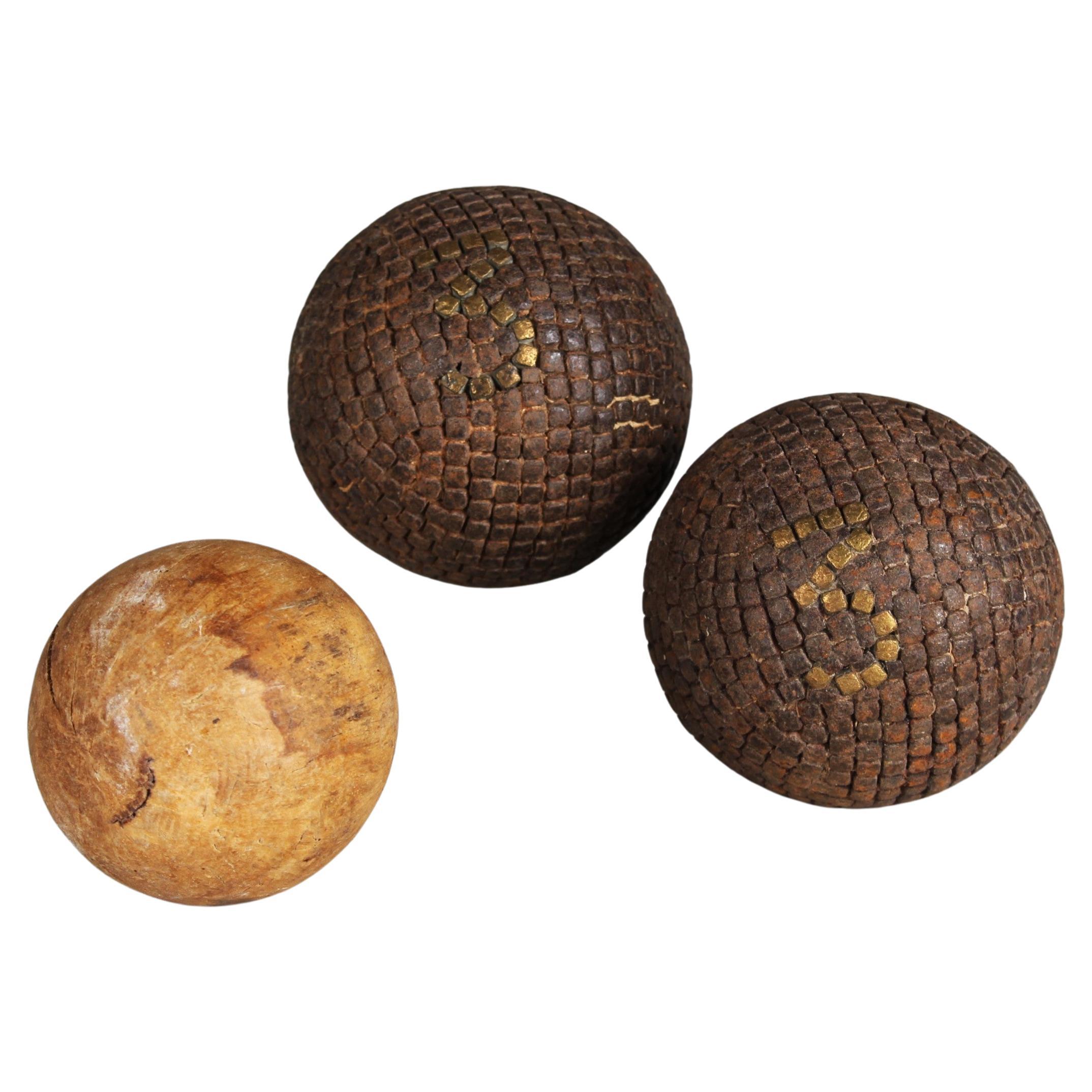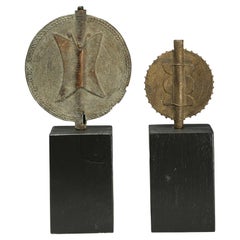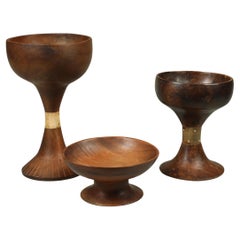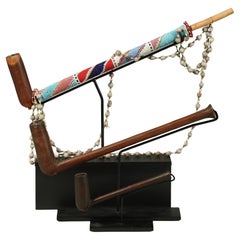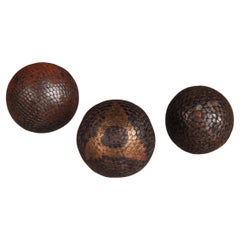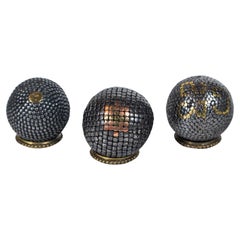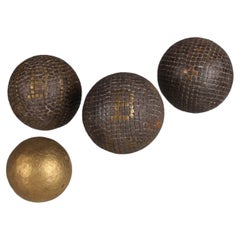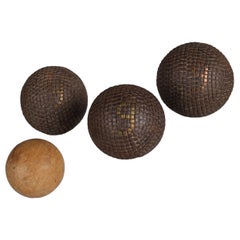Items Similar to 19th Century Bocce Balls, France, Set of Three
Want more images or videos?
Request additional images or videos from the seller
1 of 5
19th Century Bocce Balls, France, Set of Three
$2,100
£1,571.74
€1,819.97
CA$2,918.66
A$3,287.39
CHF 1,702.42
MX$39,924.10
NOK 21,624.71
SEK 20,512.86
DKK 13,579.51
Shipping
Retrieving quote...The 1stDibs Promise:
Authenticity Guarantee,
Money-Back Guarantee,
24-Hour Cancellation
About the Item
Late 19th to early 20th century bocce balls, France, set of three
boxwood, iron and brass nails.
The first ball has the letters PP in brass, the second has the number 9 in brass, while the third has the numbers 41 in brass. Sold as a group only.
- Dimensions:Height: 4 in (10.16 cm)Diameter: 4 in (10.16 cm)
- Style:Folk Art (In the Style Of)
- Materials and Techniques:
- Place of Origin:
- Period:
- Date of Manufacture:Late 19th-Early 20th Century
- Condition:Wear consistent with age and use.
- Seller Location:Point Richmond, CA
- Reference Number:Seller: ZK#28471stDibs: LU177825440313
About the Seller
5.0
Platinum Seller
Premium sellers with a 4.7+ rating and 24-hour response times
Established in 1999
1stDibs seller since 2015
679 sales on 1stDibs
Typical response time: 1 hour
- ShippingRetrieving quote...Shipping from: Point Richmond, CA
- Return Policy
Authenticity Guarantee
In the unlikely event there’s an issue with an item’s authenticity, contact us within 1 year for a full refund. DetailsMoney-Back Guarantee
If your item is not as described, is damaged in transit, or does not arrive, contact us within 7 days for a full refund. Details24-Hour Cancellation
You have a 24-hour grace period in which to reconsider your purchase, with no questions asked.Vetted Professional Sellers
Our world-class sellers must adhere to strict standards for service and quality, maintaining the integrity of our listings.Price-Match Guarantee
If you find that a seller listed the same item for a lower price elsewhere, we’ll match it.Trusted Global Delivery
Our best-in-class carrier network provides specialized shipping options worldwide, including custom delivery.More From This Seller
View AllSet of Three Antique Thai Bronze Lime Boxes
Located in Point Richmond, CA
TA04027 Set of Three Antique Thai Bronze Lime Boxes. Tall Cylinders of varying shapes and sizes:
A) Thai Bronze Lime Container in the shape of a Stupa, u...
Category
Early 20th Century Thai Tribal Metalwork
Materials
Bronze
Baule Lost Wax Cast Bronze Circular Discs Butterfly Ivory Coast Africa Based
Located in Point Richmond, CA
Circular Lost Wax Cast Bronze Discs or pendants, one with beautiful butterfly in low relief. The other has abstract design, both have finely modeled rings as background to the design...
Category
Early 20th Century Ivorian Tribal Tribal Art
Materials
Bronze
Group of Three Toraja Wood Offering Bowls, Sulawesi, Indonesia
Located in Point Richmond, CA
Group of three Toraja wood offering bowls, from Sulawesi, Indonesia. Sweet abstract mid-century forms.
Created from native hardwood and with horn rings, these strikingly sculptural w...
Category
Mid-20th Century Indonesian Tribal Tribal Art
Materials
Wood
Set of Three Vintage Zulu Long Wood Pipes on Custom Stands Beads South Africa
Located in Point Richmond, CA
Set of three vintage Zulu long wood pipes on custom metal stands, South Africa. Each on separate stand so can be arranged in multiple ways for great display...
Category
Mid-20th Century Malian Tribal Tribal Art
Materials
Wood
Set of Six Early 20th Century Carved Wood Knobkerries, South Africa
Located in Point Richmond, CA
Six Knobkerries from South Africa
A group of six knobkerries from South Africa, mounted together on a wooden base. These were originally used as weapons during battle but have evolv...
Category
Early 20th Century South African Tribal Tribal Art
Materials
Wood
Group of Four Toraja Wood Offering Bowls, Sulawesi, Indonesia Dark Patina
Located in Point Richmond, CA
Group of four Toraja wood offering bowls, from Sulawesi, Indonesia with dark deep patina from use.
Created from native hardwood and with horn rings in the center portion (except on t...
Category
Mid-20th Century Indonesian Tribal Tribal Art
Materials
Wood
You May Also Like
Antique Boule Balls Set "B", Pétanque, 1880s, France, Craftsmanship
Located in Greven, DE
Beautiful, unique Boule set of three Boule balls, France, late 19th Century.
In the 19th century, the manufacture of boules balls underwent significant development in France as the game of boules, particularly the pétanque variant, gained in popularity. The manufacture of boules balls during this period was a manual process that required expertise, precision and love to detail.
In the late 19th and early 20th centuries, particularly in rural areas of France and other Mediterranean regions, olive wood was a commonly used source of material for making boules balls. This was not only due to the availability of the material, but also to the outstanding properties of olive wood, which was characterized by hardness, strength and a rich grain.
First, the olive wood was carefully selected and shaped into raw balls, which were then sanded to the desired size and shape. The nails were then hammered into the balls one by one, making sure that they were evenly distributed and firmly anchored. Finally, the spheres were polished and coated with a protective varnish to enhance their natural beauty and protect them from the elements.
The use of nails to decorate and reinforce olive wood boules was a traditional practice that not only gave the ball a rustic aesthetic, but also improved its durability and contributed to customization. Many balls were made according to the specific requirements and preferences of the players. Nails were driven at regular intervals around the ball, with each nail hole precisely placed so as not to affect the balance and weight distribution of the ball. These nails not only served as a decorative element, but also helped to strengthen the structure of the ball and make it more resistant to the hard knocks and wear and tear during play. Individual engravings or decorations were often applied to the balls to make them unique and identify the player.
Antique boules...
Category
Antique Late 19th Century French Late Victorian Antiquities
Materials
Olive
Three Antique Petanque Balls, France, Late 19th Century
Located in Chappaqua, NY
Three Antique Pétanque Balls, France, late 19th Century. Solid wood center, covered in hammered, steel nails with accent brass and copper nails....
Category
Antique Late 19th Century French Industrial Sports Equipment and Memorab...
Materials
Brass, Copper, Steel
Antique Boule Balls Set "B", Pétanque, 1880s, France, Craftsmanship
Located in Greven, DE
Beautiful, unique Boule set of three Boule balls and one target ball, France, late 19th century.
In the 19th century, the manufacture of boules balls underwent significant development in France as the game of boules, particularly the pétanque variant, gained in popularity. The manufacture of boules balls during this period was a manual process that required expertise, precision and love to detail.
In the late 19th and early 20th centuries, particularly in rural areas of France and other Mediterranean regions, olive wood was a commonly used source of material for making boules balls. This was not only due to the availability of the material, but also to the outstanding properties of olive wood, which was characterized by hardness, strength and a rich grain.
First, the olive wood was carefully selected and shaped into raw balls, which were then sanded to the desired size and shape. The nails were then hammered into the balls one by one, making sure that they were evenly distributed and firmly anchored. Finally, the spheres were polished and coated with a protective varnish to enhance their natural beauty and protect them from the elements.
The use of nails to decorate and reinforce olive wood boules was a traditional practice that not only gave the ball a rustic aesthetic, but also improved its durability and contributed to customization. Many balls were made according to the specific requirements and preferences of the players. Nails were driven at regular intervals around the ball, with each nail hole precisely placed so as not to affect the balance and weight distribution of the ball. These nails not only served as a decorative element, but also helped to strengthen the structure of the ball and make it more resistant to the hard knocks and wear and tear during play. Individual engravings or decorations were often applied to the balls to make them unique and identify the player.
Antique boules...
Category
Antique Late 19th Century French Late Victorian Antiquities
Materials
Olive
Antique Boule Balls Set "9", Pétanque, 1880s, France, Craftsmanship
Located in Greven, DE
Beautiful, unique Boule set of three Boule balls and one target ball, France, late 19th century.
In the 19th century, the manufacture of boules balls underwent significant development in France as the game of boules, particularly the pétanque variant, gained in popularity. The manufacture of boules balls during this period was a manual process that required expertise, precision and love to detail.
In the late 19th and early 20th centuries, particularly in rural areas of France and other Mediterranean regions, olive wood was a commonly used source of material for making boules balls. This was not only due to the availability of the material, but also to the outstanding properties of olive wood, which was characterized by hardness, strength and a rich grain.
First, the olive wood was carefully selected and shaped into raw balls, which were then sanded to the desired size and shape. The nails were then hammered into the balls one by one, making sure that they were evenly distributed and firmly anchored. Finally, the spheres were polished and coated with a protective varnish to enhance their natural beauty and protect them from the elements.
The use of nails to decorate and reinforce olive wood boules was a traditional practice that not only gave the ball a rustic aesthetic, but also improved its durability and contributed to customization. Many balls were made according to the specific requirements and preferences of the players. Nails were driven at regular intervals around the ball, with each nail hole precisely placed so as not to affect the balance and weight distribution of the ball. These nails not only served as a decorative element, but also helped to strengthen the structure of the ball and make it more resistant to the hard knocks and wear and tear during play. Individual engravings or decorations were often applied to the balls to make them unique and identify the player.
Antique boules...
Category
Antique Late 19th Century French Late Victorian Antiquities
Materials
Olive
Antique Boule Set, Boule Balls, Pétanque, 1880s, France, Craftsmanship
Located in Greven, DE
Beautiful, unique Boule set of three Boule balls, France, late 19th century.
In the 19th century, antique metal boules balls experienced a renaissance that took the game of boules to a new level.
These ornately crafted balls were not only instruments of the game, but also symbols of elegance and sophistication in leisure activities.
Made from high-quality metals such as steel or brass, Boule balls were forged and polished by skilled craftsmen to ensure a smooth and even surface.
The antique boules...
Category
Antique Late 19th Century French Late Victorian Antiquities
Materials
Metal
Pair Of Antique Boule Balls "3", Pétanque, 1880s, France, Craftsmanship
Located in Greven, DE
Beautiful, unique Boule ball pair and one target ball, France, late 19th Century.
Decorated with the numer "3" on each of the Boule balls.
In the 19th century, the manufacture of b...
Category
Antique Late 19th Century French Late Victorian Antiquities
Materials
Olive
More Ways To Browse
Antique French Letters
Antique Brass Nails
Antique Bocce
Bocce Balls
Antique Bocce Balls
Bocce Set
Antique Abc Blocks
Carrom Board
Carrom Game Board
Chinese Checkers Vintage
Used Shuffleboards
Duncan Chess Set And Board
Vintage Table Top Pinball
Jeu De Grenouille
Moore Backgammon
Rare English Scrimshaw Dice
Scrimshaw Dice Sailors
Shove Ha Penny
